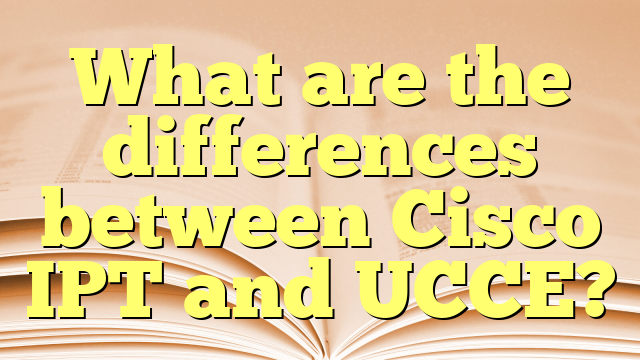Differences between Cisco IPT and UCCE
| Feature | IP Telephony (IPT) | Unified Contact Center Enterprise (UCCE) |
|---|---|---|
| Purpose | Facilitates voice communication over IP networks. | Manages and operates large-scale contact centers. |
| Primary Components | IP phones, IP PBX, gateways, media servers. | Contact center software, routing engines, reporting tools, CRM integrations. |
| Call Routing | Basic call routing and handling based on dial plans. | Advanced call routing based on skills, customer data, and business rules. |
| Scalability | Suitable for small to medium-sized enterprises. | Designed for large enterprises with high call volumes and complex requirements. |
| Integration | Integration with basic communication tools (voicemail, conferencing). | Extensive integration with CRM systems, workforce management, and analytics. |
| Reporting and Analytics | Basic call logs and usage statistics. | Detailed reporting, real-time analytics, and historical data for performance tracking. |
| Customer Interaction | Primarily voice communication. | Multi-channel communication including voice, email, chat, and social media. |
| Agent Management | Basic user management. | Advanced features like skill-based routing, agent scripting, and workforce optimization. |
| Deployment Complexity | Relatively simple setup and configuration. | Complex deployment requiring specialized skills and thorough planning. |
| Cost | Generally lower cost. | Higher cost due to advanced features and scalability. |
Detailed Explanations: (Differences between Cisco IPT and UCCE)
- Purpose:
- IPT focuses on delivering voice services over IP networks, replacing traditional telephony systems.
- UCCE is designed to manage contact center operations, including customer service and support.
- Primary Components:
- IPT includes hardware and software for voice communication.
- UCCE includes a suite of applications and tools for contact center management.
- Call Routing:
- IPT handles basic call routing.
- UCCE offers sophisticated routing based on various criteria to optimize customer service.
- Scalability:
- IPT is ideal for smaller setups.
- UCCE can handle very large setups with thousands of agents.
- Integration:
- IPT integrates with basic communication tools.
- UCCE integrates deeply with business applications and customer service tools.
- Reporting and Analytics:
- IPT provides basic data on call usage.
- UCCE offers comprehensive analytics for contact center performance.
- Customer Interaction:
- IPT is mainly for voice.
- UCCE supports multiple channels of customer interaction.
- Agent Management:
- IPT has simple user management.
- UCCE includes tools for managing agent performance and workload.
- Deployment Complexity:
- IPT is easier to deploy.
- UCCE requires detailed planning and expertise.
- Cost:
- IPT is cost-effective for basic telephony needs.
- UCCE incurs higher costs due to its advanced features and capabilities.
These differences highlight how IPT and UCCE serve different purposes and environments, with UCCE being much more suited to large, complex contact center operations.

